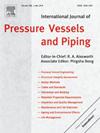Weld overlaying of corrosion-resistant filler metals on A516 G-70 carbon steel
IF 3
2区 工程技术
Q2 ENGINEERING, MECHANICAL
International Journal of Pressure Vessels and Piping
Pub Date : 2025-03-20
DOI:10.1016/j.ijpvp.2025.105514
引用次数: 0
Abstract
This study explores the application of weld overlays on A516 G-70 steel using different filler metals, including ER 2594 super duplex stainless steel, ER 2209 duplex stainless steel, and ER 316L austenitic stainless steel. The aim of the overlaying process was to enhance the corrosion resistance and erosion performance of the base alloy. Pulsed current gas tungsten arc welding was employed as the overlaying technique. Detailed microstructural assessments were performed using optical microscopy and field emission scanning electron microscopy, supplemented by energy dispersive X-ray spectroscopy. The ratio of ferrite to austenite was evaluated through X-ray diffraction analysis and measurements using a ferrite scope. Results indicated that increasing the heat input reduced the ferrite phase in the ER 2594 and ER 2209 overlays. To assess corrosion behavior, Tafel polarization and electrochemical impedance spectroscopy tests were carried out on both the substrate and the overlay materials. Among the overlays, ER 2594 produced under moderate heat input showed the best corrosion resistance, with a notably low corrosion current (icorr = 6.6 nA/cm2) and higher impedance (Z) compared to other overlays. Furthermore, erosion performance was evaluated using a slurry test with water containing 5 wt% sand particles at a flow rate of 10 m/s, with an impact angle of 30°, and varying duration. The ER 2594 overlay proved substantially lower mass loss, indicating superior erosion resistance compared to both the base and other cladding alternatives. Based on the findings, the ER 2594 considered as the most suitable overlay filler for the A516 base material.
A516 G-70碳钢上耐腐蚀填充金属的焊接堆焊
本研究探讨了不同填充金属在A516 G-70钢上的焊缝堆焊应用,包括ER 2594超级双相不锈钢、ER 2209双相不锈钢和ER 316L奥氏体不锈钢。堆焊工艺的目的是提高基体合金的耐腐蚀和冲蚀性能。采用脉冲电流钨极气体保护焊作为叠加工艺。使用光学显微镜和场发射扫描电镜进行详细的显微结构评估,并辅以能量色散x射线光谱学。通过x射线衍射分析和铁素体示波器测量,评估了铁素体与奥氏体的比例。结果表明,热输入的增加使er2594和er2209复合材料中的铁氧体相减少。为了评估腐蚀行为,对衬底和覆盖层材料进行了塔菲尔极化和电化学阻抗谱测试。其中,在中等热输入条件下产生的er2594的耐蚀性最好,腐蚀电流(icorr = 6.6 nA/cm2)明显较低,阻抗(Z)高于其他覆盖层。此外,采用含5 wt%砂粒的水、10 m/s流速、30°冲击角和不同持续时间的泥浆试验来评估侵蚀性能。事实证明,er2594覆盖层的质量损失大大降低,这表明与基材和其他覆盖层替代品相比,er2594覆盖层具有更强的抗侵蚀能力。基于研究结果,er2594被认为是A516基材最合适的覆盖填料。
本文章由计算机程序翻译,如有差异,请以英文原文为准。
求助全文
约1分钟内获得全文
求助全文
来源期刊
CiteScore
5.30
自引率
13.30%
发文量
208
审稿时长
17 months
期刊介绍:
Pressure vessel engineering technology is of importance in many branches of industry. This journal publishes the latest research results and related information on all its associated aspects, with particular emphasis on the structural integrity assessment, maintenance and life extension of pressurised process engineering plants.
The anticipated coverage of the International Journal of Pressure Vessels and Piping ranges from simple mass-produced pressure vessels to large custom-built vessels and tanks. Pressure vessels technology is a developing field, and contributions on the following topics will therefore be welcome:
• Pressure vessel engineering
• Structural integrity assessment
• Design methods
• Codes and standards
• Fabrication and welding
• Materials properties requirements
• Inspection and quality management
• Maintenance and life extension
• Ageing and environmental effects
• Life management
Of particular importance are papers covering aspects of significant practical application which could lead to major improvements in economy, reliability and useful life. While most accepted papers represent the results of original applied research, critical reviews of topical interest by world-leading experts will also appear from time to time.
International Journal of Pressure Vessels and Piping is indispensable reading for engineering professionals involved in the energy, petrochemicals, process plant, transport, aerospace and related industries; for manufacturers of pressure vessels and ancillary equipment; and for academics pursuing research in these areas.

 求助内容:
求助内容: 应助结果提醒方式:
应助结果提醒方式:


